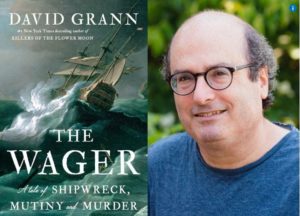The Wager is a masterclass in story-telling
By Ken McGoogan / Special to the Toronto Star
In March 1741, during a ferocious storm at the foot of South America, a creaky wooden ship called the Wager sailed into the Drake Passage — the most notorious channel in the world. The gunner on board, John Bulkeley, felt the vessel “hurtling on an avalanche of water, cascading into a chasm devoid of light. All he could discern behind him was a looming mountain of water; in front of him nothing but another terrifying mountain.” The ship pitched, heaved, groaned, and splintered. She collided with a wave and “the mizzen, a vital mast, toppled over like an axed tree, crashing down with its rigging and sails into the sea.”
So writes author David Grann in “The Wager: A Tale of Shipwreck, Mutiny and Murder.” At this point, about a third of the way through the book, you the reader may find yourself saying, “Whoa! this could make one heck of a movie — like “The Perfect Storm” only more spectacular.” If so, you wouldn’t be the first. Director Martin Scorsese and actor Leonardo DiCaprio, who recently finished filming a previous Grann bestseller (“Killers of the Flower Moon”), have already signed on to adapt this one.
At 4:30 one morning off the coast of Patagonia, in the darkness of yet another torrential downpour, the Wager hit a rock. It lurched and teetered and began to sink. Some sailors fell to their knees in prayer but, as water poured into the hold and masts tumbled onto the deck, a couple of men climbed to a high point and, through a mist, spotted an island. Of the 250 men and boys who had embarked in Portsmouth, 145 struggled to shore and apparent safety. But then, over the next five months, hardship and hunger reduced Royal Navy discipline to “Lord of the Flies”-anarchy. Say hello to warring factions, thievery, whippings, cannibalism and public murder. Their numbers diminishing, eighty-odd men contrived to escape the island.
Simply put, Grann is working to a three-part formula. One: unearth a tremendous story from within a forgotten haystack. Two: spend months and months and months researching it. Three: write the narrative with the artistry of a superb novelist. One, two, three. How hard is that?
With “The Wager,” as indicated above, Grann has dug up a story that bears comparison with “Mutiny on the Bounty.” Enough said about that? He spent five years working on the book — roughly half that haunting archives and analyzing contradictory accounts. But he didn’t stop there. In his acknowledgments, Grann thanks “a whirlwind explorer” who helped him organize his own three-week journey to Wager Island. Grann located pieces of the wrecked ship and gained a “better understanding of what the castaways had experienced.” His depth of perception informs every page.
That brings us to artistry. Early in his career, Grann spent one year doing an MFA at Boston University. He may well have written “a very bad novel,” as he says, but from writing fiction he learned how to wield Point of View — how to let a story unfold as it happens through its main characters, who in this case, number three. Instead of delivering information from an authorial perch, he uses them to carry the narrative load.
Watch how he sets up expository passages. One, ‘[David] Cheap knew what a cracking ship the Centurion was.” Two, “John Bulkeley scoured the horizon for South America.” Three, “John Byron stared in awe at the waves that broke over the Wager, bandying the 123-foot vessel about as if it were no more than a pitiful rowboat.” One, two, three. Grann makes it look easy, even while exploring how desperate people behave in life-and-death situations. Hint: not well. This book is a tour de force.
